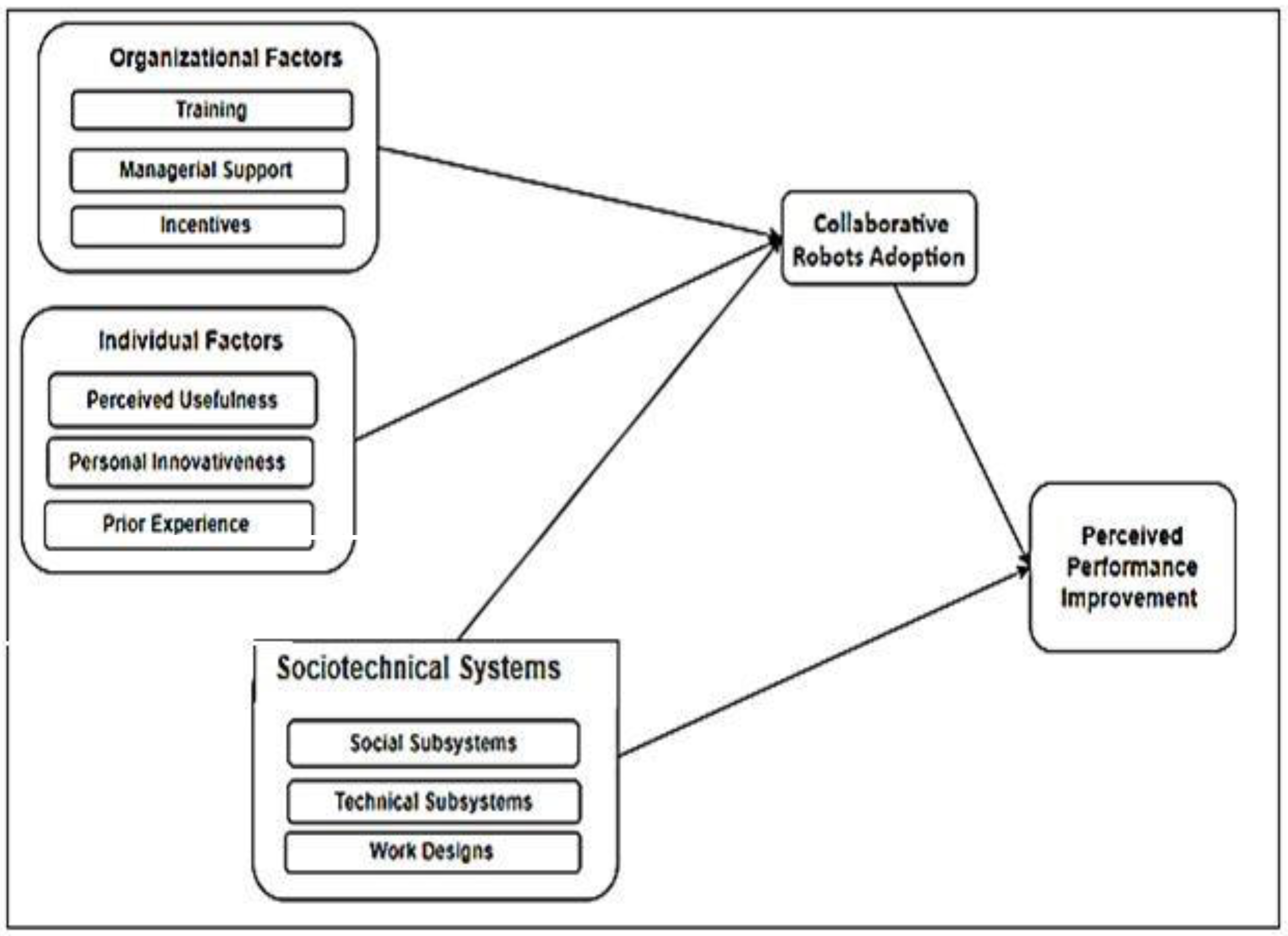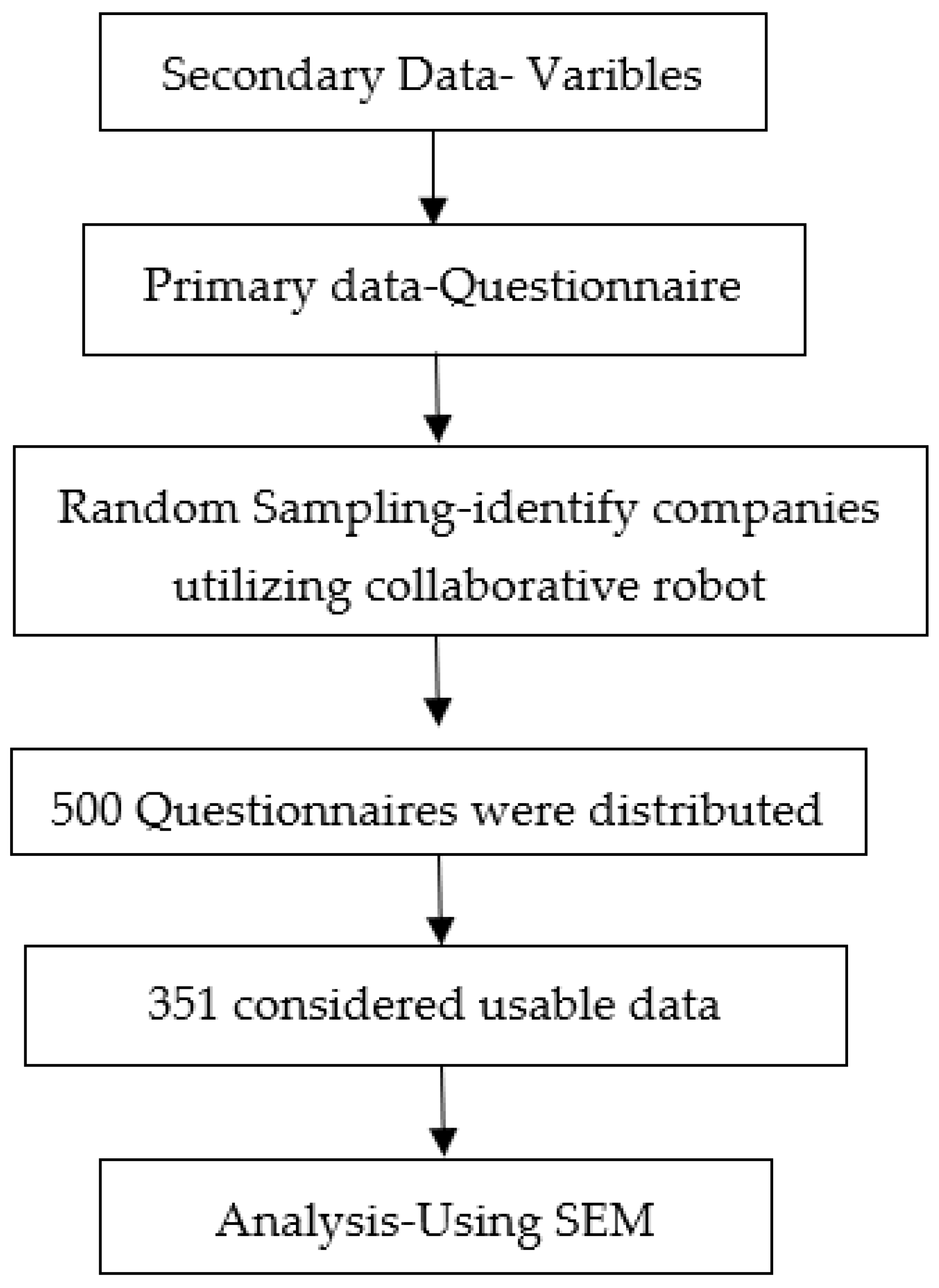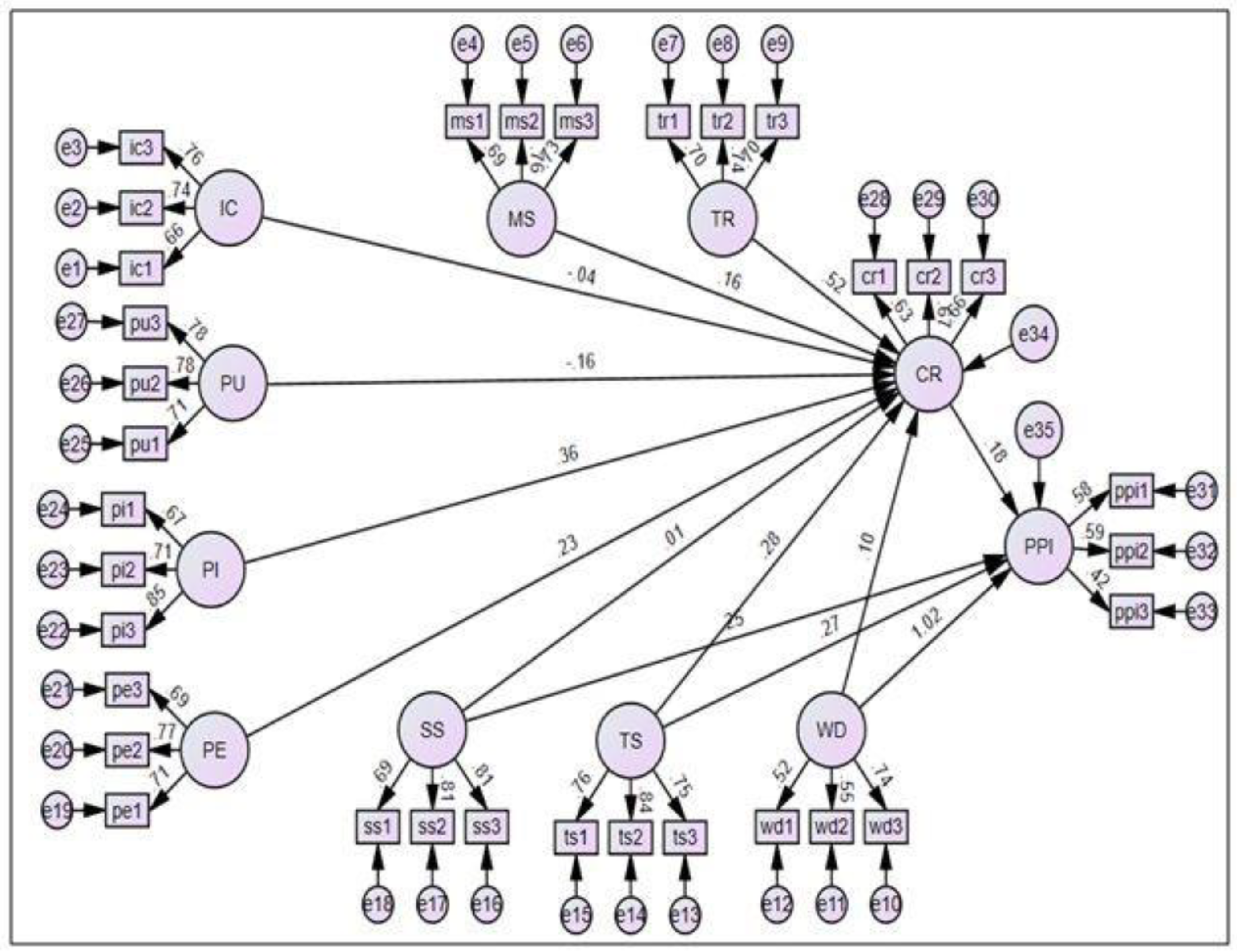Assessing the Influence of Collaborative Technology Adoption—Mediating Role of Sociotechnical, Organizational, and Economic Factors
Abstract
1. Introduction
2. Literature Review
2.1. Organizational Factors
2.2. Economic Factors
2.3. Sociotechnical Systems
3. Methdology
Research Population
| Variables | Observed Variables | Sources |
|---|---|---|
| Training | Receiving training would help me understand about collaborative robot adoption. Training is necessary for me to use collaborative robots. If I receive training, it would be easy for me to use collabo-rative robots. | [37,38] |
| Incentives | Adoption of collaborative robots is expensive and sponsorship may be required | [21] |
| I need incentives to start using collaborative robots | ||
| In our organizations, incentives helped us in adopting collaborative robots | ||
| Collaborative Robots Adoption | I would encourage my company to start using collaborative robots I would encourage my company to start using collaborative robots I think my company should use collaborative robots in the future I think it is the right decision to start using collaborative robots | [39] |
| Managerial support | I think my company should use collaborative robots in the future | [40] |
| I think it is the right decision to start using collaborative robots | ||
| I think it is the right decision to start using collaborative robots | ||
| Perceived Usefulness | I think that collaborative robots are useful for my life | [41,42] |
| Using collaborative robots increases my productivity | ||
| Using collaborative robots helps me conveniently perform many tasks | ||
| collaborative robots provide very useful service and information to me | ||
| Work Design | Collaborative robots would help ensure employees job description will achieve its mission Employees job duties would be achieved easily with collaborative robots Employees performance would be enhanced by using collaborative robots Work systems would be effectively defined through collaborative robots | [43] |
| Personal Innovativeness | Generally, I am interested in trying out collaborative robots | [44,45] |
| Whenever I hear about collaborative robots, I am always eager to try it out | ||
| Prior Experience | I have prior experience in using collaborative robots | [46,47] |
| Prior experience is necessary to effectively use collaborative robots | ||
| If I have prior experience in using collaborative robots it would be easy for me to adopt | ||
| Prior experience would increase the effectiveness of using collaborative robots | ||
| Technical Subsystems | Collaborative robots would help people work together on interrelated activities | [48,49] |
| Collaborative robots using would help effective use of knowledge, techniques, equipment and facilities | ||
| Employees and their social relationships would be improved by collaborative robots | ||
| Social Subsystems | Supervisory relationship with the employees would enhance use of collaborative robots | [50,51] |
| Peer group interaction is important for collaborative robots | ||
| Proper governance is resources is important for adopting collaborative robots | ||
| Collaborative robots require effective processing and marketing aspects | ||
| Perceived Per-formance Im-provement | Performance would be better if collaborative robot tech-nology is used. Performance for those using collaborative robots is better than for those not using. Companies using collaborative robots are more success-ful. Employees would perform better is they are allowed to use collaborative robots. | [52] |
4. Results and Discussion
Discussion
5. Conclusions
Author Contributions
Funding
Institutional Review Board Statement
Informed Consent Statement
Data Availability Statement
Acknowledgments
Conflicts of Interest
References
- Bednar, P.M.; Welch, C. Socio-technical perspectives on smart working: Creating meaningful and sustainable systems. Inf. Syst. Front. 2020, 22, 281–298. [Google Scholar] [CrossRef]
- Berx, N.; Arie, A.; Decré, W.; Pintelon, L. Assessing system-wide safety readiness for successful human–robot collaboration adoption. Safety 2022, 8, 48. [Google Scholar] [CrossRef]
- Ahmad, M.; Beddu, S.; binti Itam, Z.; Alanimi, F.B.I. State of the art compendium of macro and micro energies. Adv. Sci. Tech. Res. 2019, 13, 88–109. [Google Scholar] [CrossRef]
- Yeamkuan, S.; Chamnongthai, K.; Pichitwong, W. A 3D Point-of-Intention Estimation Method Using Multimodal Fusion of Hand Pointing, Eye Gaze and Depth Sensing for Collaborative Robots. IEEE Sens. J. 2021, 22, 2700–2710. [Google Scholar] [CrossRef]
- Sadangharn, P. A multidimensional analysis of robotic deployment in thai hotels. Int. J. Soc. Robot. 2021, 14, 859–873. [Google Scholar] [CrossRef] [PubMed]
- Antonelli, D.; Bruno, G. Dynamic distribution of assembly tasks in a collaborative workcell of humans and robots. FME Trans. 2019, 47, 723–730. [Google Scholar] [CrossRef]
- Paniti, I.; Nacsa, J.; Szűr, D.; Rácz, S.; Tóth, J. Complementary Manipulator Tool Development for Safe Cobot-Assisted Hydroponics. Hung. J. Ind. Chem. 2021, 49, 85–89. [Google Scholar] [CrossRef]
- Adriaensen, A.; Costantino, F.; Di Gravio, G.; Patriarca, R. Teaming with industrial cobots: A socio-technical perspective on safety analysis. Hum. Factors Ergon. Manuf. Serv. Ind. 2021, 32, 173–198. [Google Scholar] [CrossRef]
- Konuikhovskaia, A. Five Trends in Russian Robotics; International Federation of Robotics: Frankfurt, Germany, 2019; Available online: https://ifr.org/post/five-trends-in-russian-robotics (accessed on 10 September 2022).
- Galin, R.; Meshcheryakov, R. Automation and robotics in the context of Industry 4.0: The shift to collaborative robots. In IOP Conference Series: Materials Science and Engineering; IOP Publishing: Bristol, UK, 2019; Volume 537, p. 032073. [Google Scholar] [CrossRef]
- Kantatasiri, P.; Jaroenwanit, P.; Brown, R. The influencing of young consumers shopping style on attitude toward the environmentally friendly food products in Thailand. Int. Bus. Manag. 2015, 9, 105–110. [Google Scholar] [CrossRef]
- Kasilingam, D.L. Understanding the attitude and intention to use smartphone chatbots for shopping. Technol. Soc. 2020, 62, 101280. [Google Scholar] [CrossRef]
- Katada, Y.; Hasegawa, S.; Yamashita, K.; Okazaki, N.; Ohkura, K. Swarm crawler robots using lévy flight for targets exploration in large environments. Robotics 2022, 11, 76. [Google Scholar] [CrossRef]
- Khalid, B.; Chaveesuk, S.; Chaiyasoonthorn, W. MOOCs adoption in higher education: A management perspective. Pol. J. Manag. Stud. 2021, 23, 239–256. [Google Scholar] [CrossRef]
- Crofts, M.; Fraunholz, B.; Warren, M. Using the sociotechnical approach in global software developments: Is the theory relevant today? In ACIS 2008 Proceedings; 2008; Volume 61, Available online: http://aisel.aisnet.org/acis2008/61 (accessed on 10 September 2022).
- Chaiyasoonthorn, W.; Khalid, B.; Chaveesuk, S. Success of smart cities development with community’s acceptance of new technologies. In Proceedings of the 9th International Conference on Information Communication and Management, Prague, Czech Republic, 23–26 August 2019. [Google Scholar] [CrossRef]
- Leidner, S.; Baden, D.; Ashleigh, M.J. Green (environmental) HRM: Aligning ideals with appropriate practices. Pers. Rev. 2019, 48, 1169–1185. [Google Scholar] [CrossRef]
- Banerjee, A.; Chattopadhyay, R.; Duflo, E.; Keniston, D.; Singh, N. Improving police performance in Rajasthan, India: Experimental evidence on incentives, managerial autonomy, and training. Am. Econ. J. Econ. Policy 2021, 13, 36–66. [Google Scholar] [CrossRef]
- Fleischman, G.M.; Johnson, E.N.; Walker, K.B.; Valentine, S.R. Ethics versus outcomes: Managerial responses to incentive-driven and goal-induced employee behavior. J. Bus. Ethics 2019, 158, 951–967. [Google Scholar] [CrossRef]
- Rigby, C.S.; Ryan, R.M. Self-determination theory in human resource development: New directions and practical considerations. Adv. Dev. Hum. Resour. 2018, 20, 133–147. [Google Scholar] [CrossRef]
- Andrews, D.; Nicoletti, G.; Timiliotis, C. Digital technology diffusion: A matter of capabilities, incentives or both? Eur. Econ. Rev. 2020, 128, 103513. [Google Scholar] [CrossRef]
- Thürer, M.; Godinho Filho, M.; Stevenson, M.; Fredendall, L.D. Competitive priorities of small manufacturers in Brazil. Ind. Manag. Data Syst. 2013, 113, 856–874. [Google Scholar] [CrossRef]
- Slack, N.; Lewis, M. Operations Strategy; Editora Brookman: Porto Alegre, Brazil, 2017. [Google Scholar]
- Jain, B.; Adil, G.K.; Ananthakumar, U. Development of questionnaire to assess manufacturing capability along different decision areas. Int. J. Adv. Manuf. Technol. 2014, 71, 2091–2105. [Google Scholar] [CrossRef]
- Min, S.; So KK, F.; Jeong, M. Consumer adoption of the Uber mobile application: Insights from diffusion of innovation theory and technology acceptance model. J. Travel Tour. Mark. 2019, 36, 770–783. [Google Scholar] [CrossRef]
- Al-Rahmi, W.M.; Yahaya, N.; Aldraiweesh, A.A.; Alamri, M.M.; Aljarboa, N.A.; Alturki, U.; Aljeraiwi, A.A. Integrating technology acceptance model with innovation diffusion theory: An empirical investigation on students’ intention to use E-learning systems. IEEE Access 2019, 7, 26797–26809. [Google Scholar] [CrossRef]
- Chavoshi, A.; Hamidi, H. Social, individual, technological and pedagogical factors influencing mobile learning acceptance in higher education: A case from Iran. Telemat. Inform. 2019, 38, 133–165. [Google Scholar] [CrossRef]
- Wang, C.R.; Jeong, M. What makes you choose Airbnb again? An examination of users’ perceptions toward the website and their stay. Int. J. Hosp. Manag. 2018, 74, 162–170. [Google Scholar] [CrossRef]
- Ullah, S.; Khan, U.; Rahman, K.U.; Ullah, A. Problems and Benefits of the China-Pakistan Economic Corridor (CPEC) for Local People in Pakistan: A Critical Review. Asian Perspect. 2021, 45, 861–876. [Google Scholar] [CrossRef]
- Sansom, K.; Jaroenwanit, P. A mediating role and influence of the relationship marketing success toward cluster productivity in Thailand. Int. Bus. Manag. 2016, 10, 416–422. [Google Scholar] [CrossRef]
- Sony, M.; Naik, S. Industry 4.0 integration with socio-technical systems theory: A systematic review and proposed theoretical model. Technol. Soc. 2020, 61, 101248. [Google Scholar] [CrossRef]
- Liu, J.; Hu, H.; Tong, X.; Zhu, Q. Behavioral and technical perspectives of green supply chain management practices: Empirical evidence from an emerging market. Transp. Res. Part E Logist. Transp. Rev. 2020, 140, 102013. [Google Scholar] [CrossRef]
- Branny, A.; Møller, M.S.; Korpilo, S.; McPhearson, T.; Gulsrud, N.; Olafsson, A.S.; Andersson, E. Smarter greener cities through a social-ecological-technological systems approach. Curr. Opin. Environ. Sustain. 2022, 55, 101168. [Google Scholar] [CrossRef]
- Soliman, M.; Saurin, T.A.; Anzanello, M.J. The impacts of lean production on the complexity of socio-technical systems. Int. J. Prod. Econ. 2018, 197, 342–357. [Google Scholar] [CrossRef]
- Russian Robotics Companies. Available online: https://www.therobotreport.com/russian-robotics-companies/ (accessed on 20 July 2021).
- Tracxn. Industrial Robotics Startups in Russia. 2022. Available online: https://tracxn.com/explore/Industrial-Robotics-Startups-in-Russia (accessed on 10 September 2022).
- Boothby, D.; Dufour, A.; Tang, J. Technology adoption, training and productivity performance. Res. Policy 2010, 39, 650–661. [Google Scholar] [CrossRef]
- Nakano, Y.; Tsusaka, T.W.; Aida, T.; Pede, V.O. Is farmer-to-farmer extension effective? The impact of training on technology adoption and rice farming productivity in Tanzania. World Dev. 2018, 105, 336–351. [Google Scholar] [CrossRef]
- Agarwal, R.; Prasad, J. Are Economic Differences Germane to the Acceptance of New Information Technologies? Decis. Sci. 1999, 30, 361–391. [Google Scholar] [CrossRef]
- Hsu, H.Y.; Liu, F.H.; Tsou, H.T.; ad Chen, L.J. Openness of technology adoption, top management support and service innovation: A social innovation perspective. J. Bus. Ind. Mark. 2019, 34, 575–590. [Google Scholar] [CrossRef]
- Davis, F.D. Perceived usefulness, perceived ease of use, and user acceptance of information technology. MIS Q. 1989, 13, 319–340. [Google Scholar] [CrossRef]
- Cho, J.; Kim, B.; Jeon, J.; Park, S. Perceived usefulness and easiness of information and communication technologies and volunteering among older adults. J. Gerontol. Soc. Work. 2020, 63, 428–446. [Google Scholar] [CrossRef]
- Humphrey, S.E.; Nahrgang, J.D.; Morgeson, F.P. Integrating motivational, social, and contextual work design features: A meta-analytic summary and theoretical extension of the work design literature. J. Appl. Psychol. 2007, 92, 1332. [Google Scholar] [CrossRef]
- Lian, S.; Chen, X.; Wang, J. Content distribution and copyright authentication based on combined indexing and watermarking. Multimed. Tools Appl. 2012, 57, 49–66. [Google Scholar] [CrossRef]
- Barnes, D.; Hinton, C. Reconceptualizing e-business performance measurement using an innovation adoption framework. International. J. Product. Perform. Manag. 2002, 61, 502–517. [Google Scholar] [CrossRef]
- Varma, S.; Marler, J.H. The dual nature of prior computer experience: More is not necessarily better for technology acceptance. Comput. Hum. Behav. 2013, 29, 1475–1482. [Google Scholar] [CrossRef]
- Xu, Y.; Jin, L.; Deifell, E.; Angus, K. Chinese character instruction online: A technology acceptance perspective in emergency remote teaching. System 2021, 100, 102542. [Google Scholar] [CrossRef]
- Corrado, V.; Ballarini, I.; Dirutigliano, D.; Murano, G. Verification of the new Ministerial Decree about minimum requirements for the energy performance of buildings. Energy Procedia 2016, 101, 200–207. [Google Scholar] [CrossRef]
- Hillier, B. The city as a socio-technical system: A spatial reformulation in the light of the levels problem and the parallel problem. In Digital Urban Modeling and Simulation; Springer: Berlin/Heidelberg, Germany, 2012; pp. 24–48. [Google Scholar] [CrossRef]
- Moraine, M.; Duru, M.; Therond, O. A social-ecological framework for analyzing and designing integrated crop–livestock systems from farm to territory levels. Renew. Agric. Food Syst. 2017, 32, 43–56. [Google Scholar] [CrossRef]
- Alänge, S.; Lundqvist, M. Sustainable Business Development: An Anthology about Realizing Ideas-Beta Version; Chalmers University Press: Gothenburg, Sweden, 2010. [Google Scholar]
- Shahzad, K.; Bashir, S.; Ramay, M.I. Impact of HR practices on perceived performance of university teachers in Pakistan. Int. Rev. Bus. Res. Pap. 2008, 4, 302–315. [Google Scholar]
- Jöreskog, K.G.; Sörbom, D. LISREL 8: Structural Equation Modeling with the SIMPLIS Command Language; Scientific Software International: New York, NY, USA, 1993. [Google Scholar]
- Hayes, R.H.; Wheelwright, S.C. Restoring Our Competitive Edge: Competing through Manufacturing; Wiley: Hoboken, NJ, USA, 1984. [Google Scholar]
- Turoń, K. From the Classic Business Model to Open Innovation and Data Sharing—The Concept of an Open Car-Sharing Business Model. J. Open Innov. Technol. Mark. Complex. 2022, 8, 36. [Google Scholar] [CrossRef]
- Nicolescu, O.; Nicolescu, C. Transition to the Knowledge-Based Economy and the Digital Economy–The Context of the Company Management, Stakeholder, and Social Responsibility Approach. In Stakeholder Management and Social Responsibility; Routledge: London, UK, 2022; pp. 16–50. [Google Scholar]
- Giganti, P.; Falcone, P.M. Strategic Niche Management for Sustainability: A Systematic Literature Review. Sustainability 2022, 14, 1680. [Google Scholar] [CrossRef]
- Hoicka, C.E.; Zhao, Y.; McMaster, M.L.; Das, R.R. Diffusion of demand-side low-carbon innovations and socio-technical energy system change. Renew. Sustain. Energy Transit. 2022, 2, 100034. [Google Scholar] [CrossRef]
- Giganti, P.; Falcone, P.M. Socio-technical transitions and innovation niches: The case of the virtual and augmented reality in Europe. AIMS Energy 2021, 9, 755–774. [Google Scholar] [CrossRef]
- Turoń, K.; Golba, D.; Czech, P. The analysis of progress CSR good practices areas in logistic companies based on reports “Responsible Business in Poland. Good Practices” in 2010–2014. Sci. J. Sil. Univ. Technol. Ser. Transp. 2015, 89, 163–171. [Google Scholar] [CrossRef]



| No of Items | Cronbach Alpha |
|---|---|
| 11 | 0.847 |
| Hypothesis | Paths | Estimate | S.E. | C.R. | p | ||
|---|---|---|---|---|---|---|---|
| H1 | Organizational Factors | ||||||
| TR | → | CR | 0.396 | 0.060 | 6.613 | *** | |
| MS | → | CR | 0.126 | 0.050 | 2.541 | 0.011 | |
| IC | → | CR | −0.034 | 0.048 | −0.706 | 0.480 | |
| H2 | Economic Factors | ||||||
| PU | → | CR | −0.126 | 0.049 | −2.569 | 0.010 | |
| PI | → | CR | 0.236 | 0.043 | 5.446 | *** | |
| PE | → | CR | 0.180 | 0.050 | 3.593 | *** | |
| H3 | Sociotechnical Systems | ||||||
| WD | → | CR | 0.056 | 0.035 | 1.588 | 0.112 | |
| TS | → | CR | 0.205 | 0.046 | 4.500 | *** | |
| SS | → | CR | 0.010 | 0.040 | 0.242 | 0.809 | |
| H4 | Sociotechnical systems | ||||||
| WD | → | PPI | 0.652 | 0.074 | 8.851 | *** | |
| TS | → | PPI | 0.219 | 0.052 | 4.234 | *** | |
| SS | → | PPI | 0.195 | 0.046 | 4.257 | *** | |
| H5 | CR | → | PPI | 0.203 | 0.076 | 2.680 | 0.007 |
Publisher’s Note: MDPI stays neutral with regard to jurisdictional claims in published maps and institutional affiliations. |
© 2022 by the authors. Licensee MDPI, Basel, Switzerland. This article is an open access article distributed under the terms and conditions of the Creative Commons Attribution (CC BY) license (https://creativecommons.org/licenses/by/4.0/).
Share and Cite
Zemlyak, S.; Gusarova, O.; Sivakova, S. Assessing the Influence of Collaborative Technology Adoption—Mediating Role of Sociotechnical, Organizational, and Economic Factors. Sustainability 2022, 14, 14271. https://doi.org/10.3390/su142114271
Zemlyak S, Gusarova O, Sivakova S. Assessing the Influence of Collaborative Technology Adoption—Mediating Role of Sociotechnical, Organizational, and Economic Factors. Sustainability. 2022; 14(21):14271. https://doi.org/10.3390/su142114271
Chicago/Turabian StyleZemlyak, Svetlana, Olga Gusarova, and Svetlana Sivakova. 2022. "Assessing the Influence of Collaborative Technology Adoption—Mediating Role of Sociotechnical, Organizational, and Economic Factors" Sustainability 14, no. 21: 14271. https://doi.org/10.3390/su142114271
APA StyleZemlyak, S., Gusarova, O., & Sivakova, S. (2022). Assessing the Influence of Collaborative Technology Adoption—Mediating Role of Sociotechnical, Organizational, and Economic Factors. Sustainability, 14(21), 14271. https://doi.org/10.3390/su142114271





